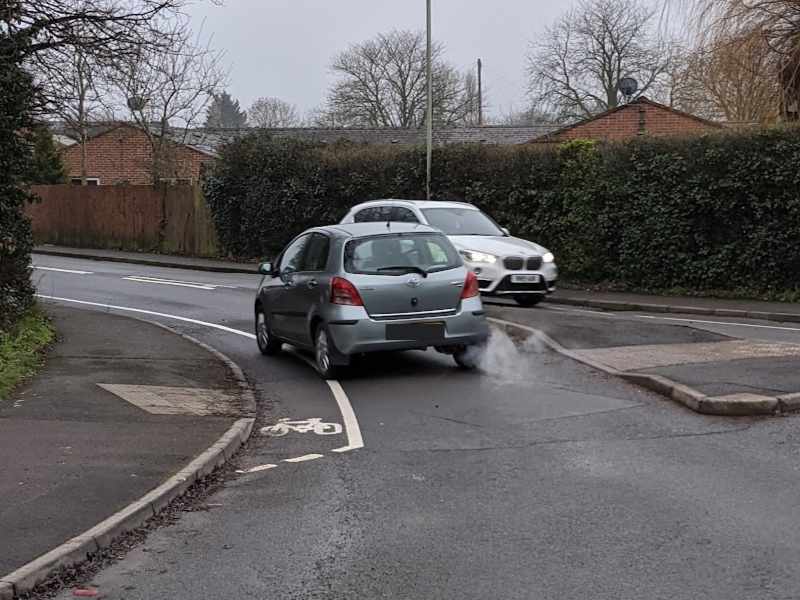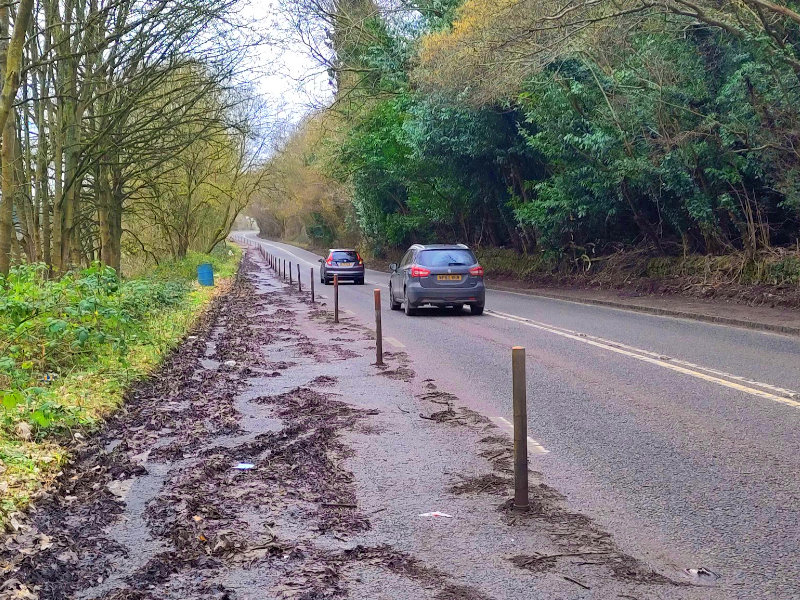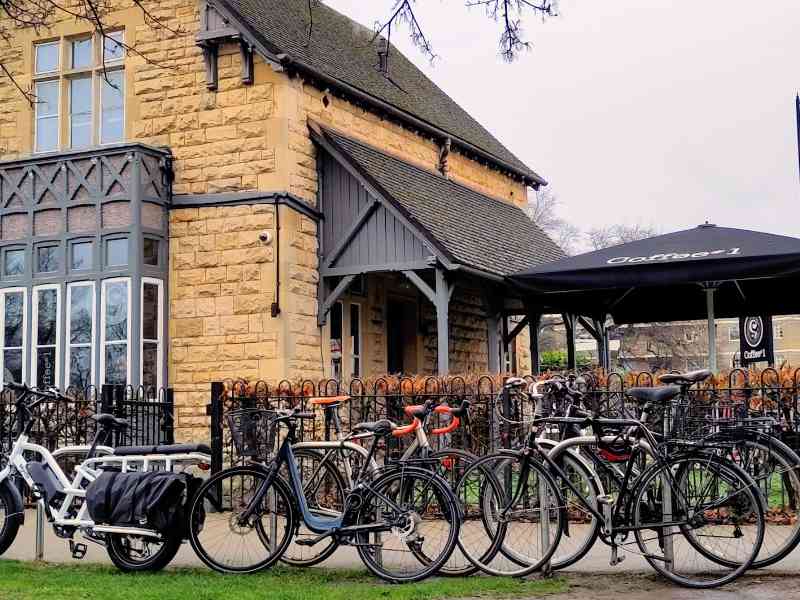The mood of the Cycling Campaign’s year has, it seems, mirrored the path of national active travel narratives and, as we approach the AGM, the publication of the current government’s ‘for motorists’ charter marks a particularly low point for those seeking to use more sustainable and active modes of transport, and those who want to see reduced road harm on our streets. This national story echoes a frustrating year for the C&TCC’s committee.
Despite increasing our efforts to engage with Gloucestershire County Council, we continued to be approached for comment on new schemes only when they were almost totally designed, and despite significant time and expertise invested, we saw even minor changes being ignored or dismissed, whilst major amendments were made to schemes to favour motor flows.
The ‘cycle spine’ has also continued to absorb almost the entire strategic prioritisation of the council, with little evolution of the local network, and with only half the route funded, this looks set to continue for several more years, particularly in the context of the severe cuts in national active travel monies.
We also approach the 2023 AGM with the Campaign facing a challenge to its sustainability. One of our active committee members, who has supported us through the reinvigoration of the website and communications, has moved away to take up a new job in a different area, and other committee members, well into retirement, are wanting to step back. This leaves a lack of time and leadership for the year ahead.
See this post for outcome of AGM
The Campaign will only continue if new volunteers are found to take forwards the diversity of activity required. With this, though, is the opportunity for them to evolve the priorities of the Campaign, particularly as we look at the very limited impact that the technical contributions of our approach has delivered in recent years. We are encouraged by the new cycling communities appearing in and around Gloucestershire, and the relative resilience of local cycling levels.
We believe that there is both space and need for an active advocacy body to represent those in Cheltenham and Tewkesbury, and have written to our members to see if others are now ready to pick up this baton.
Despite the challenges, there are several key activities that we have delivered this year.
Consultation on Gloucestershire’s first mini Holland & Hatherley Safer Streets
We promoted and supported members and contacts to respond to the design of Gloucestershire’s first Low Traffic Neighbourhood, seeking to provide an improved street environment for the local communities that could access the Honeybourne Line and the A40 WCTIS route. We highlighted opportunities for improving network density, and the key standards to which the scheme needed to adhere.

Sadly, with the announcement by the Prime Minister that councils will not be supported in these schemes, we understand Gloucestershire County Council has abandoned development, and the disappointing proposals that we have previously seen are to be resurrected as an alternative.
We also responded generally positively to the Hatherley Safer Streets proposals, which sought to introduce 20mph limits to a residential area in west Cheltenham. We provided some insight into the risks of some of the proposed cycle facilities, and made suggestions for better alternatives. We hope that the scheme survives the current government opposition to 20mph zones, and are waiting to see if any of our recommendations on the cycle facilities are adopted.
Moving Traffic Offences Response
We responded to the Gloucestershire consultation on Moving Traffic Offences enforcement through ANPR, highlighting the opportunity at Alstone Lane, Lower High Street and Parabola Road for effective enforcement to improve safety. We also suggested that there was opportunity to extend the scheme at Parabola Road to protect cyclists using the parallel crossing, but were advised that the limits of the enforcement were pre-set and could not be varied.
We noted a positive cabinet paper report to proceed with the measures, but are not aware that GCC have commenced enforcement. The government’s new ‘ for drivers’ charter shared in October 2023 also makes reference to modifying Local Authority rights to access ANPR databases, and we are therefore unclear as to whether we can expect to see the benefits of these schemes in Gloucestershire.
Cheltenham Air Quality Action Plan response
We made several key responses to the Cheltenham Air Quality Action Plan, which focussed on responding to local air quality excesses near the Lower High Street and Royal Mail central office.
We highlighted the risk of assuming the electrification of the private motor vehicle fleet would deliver sufficient improvements in a timely fashion, and that assuming the current local cycling and walking infrastructure plan was sufficient to support modal shift was erroneous.
We noted the risk that attempts to improve motor vehicle flow around the A4019/B4633 junction could not come at the expense of compromising what is already a very significant barrier for west/east cycling into Cheltenham Town Centre.
We received promising initial engagement from Cheltenham Borough Council to our response, but have not seen any further plans move forward.
A435 Charlton Hill Closure
We attempted a range of engagements with Gloucestershire County Council through the year related to the A435 Charlton Hill closure. Whilst serving only longer distance riders, we believe that the block closure to all road users, including pedestrians and cyclists, reflected a consistently poor approach to works planning by the council, necessitating an inappropriate and lengthy diversion.

We also attempted to understand the rationale for the separated facilities proposed to replace the crawler lane given the inability of the bank to support a second motor vehicle lane any more. Conversations and plans on this were opaque during construction, but we have attempted to caution on the debris and maintenance risks, a common problem that is now emerging across Gloucestershire’s separated cycle network, and for which the council currently has no clear plan or investment to address.
Gloucestershire Constabulary and road aggression
We were encouraged to see Operation Snap launch this year, with improved opportunities for reporting of motor vehicle offences. Feedback has been mixed, but committee members have generally found better dialogue with the police on the need for road harm reduction activities and support of those who are cycling.
One area of challenge that has remained is the treatment of cycle users through streetworks, and where parallel separated cycle facilities are available. We have received increased reports in these circumstances of aggressive driving being used to threaten and endanger cyclists, and have on several occasions escalated poor streetwork and communications practice to contractors and the county council.
Racecourse roundabout to Honeybourne Line consultation response.
We responded to the next section of the proposed cycle spine between the end of the Honeybourne Line and the racecourse roundabout, bringing the feedback of our members on their experiences with other sections, including concerns about surfacing, drainage, and poor design that brings conflict between pedestrians and cycle users.
We also sought to demonstrate where there were opportunities to increase the density of the cycling network, for example through better connections into and across Pitville Park.
Sadly, in reflection of the general level of engagement by Gloucestershire County Council, whilst we received a lengthy and technical reply, the only amendment made to our contribution was moving a bollard that had been placed in the path of cycle users. At the end of this year, we have also noted that the county has published preliminary consultation plans on a route through Cheltenham Town Centre, but that public feedback is not sought at this time, and that the route currently has no identified funding source.
Honeybourne Line
The Honeybourne Line, despite periods when it is increasingly congested with mixed pedestrian and cycle traffic, remains an important part of the local cycle network, and has throughout the years been a campaign focus.
This year, we have continued to focus on seeking resolution of the damage to connectivity caused by the GWR/Network Rail forecourt scheme at Cheltenham Spa station, and to seek progress on the link to connect the line to Shelburne Road, south Cheltenham and the A40.
This included proposing a dropped kerb and a revised marking scheme to reconnect the access point directly under the bridge, and to secure the removal of the ‘Cyclists Dismount’ sign.
At every stage, we have faced excuses and delays from Network Rail, and changing contacts within Sustrans and GWR have made communication difficult. We also saw deadlines pass, and delays to the works, which culminated at Easter 2023 when GWR announced that costs had risen and the Department for Transport had withdrawn support for the project. Given the vast quantities of cycle-rail funding allocated to Cheltenham, we raised concerns about this and launched a petition that attracted local media coverage and secured over one thousand signatures. We have also sought to engage behind the scenes with local political leaders and GWR.
We have been offered some glimmers of hope through these conversations, but based on our experiences of collaboration in recent years, will not be convinced until we see works ‘on the ground’.
Socials
One of the most enjoyable parts of the calendar, and a welcome break from frustrating engagements with the organisations responsible for improving conditions for active travel, has been connecting better with local cycle users.

We enjoyed breakfast meetups and a Deya social, as well as sharing the work of the Campaign at a Cheltenham sustainable travel event and a pop up on air quality, and continued to attract engagement and feedback through our website and growing newsletter. The committee has met monthly, and welcomed occasional members to our zoom meetings, helping us as we have wrestled with the growing challenge of promoting active travel, and seeking ways that we can encourage local communities to enjoy the benefits of cycling in and around our towns.
As we look ahead to a difficult period, both for the Campaign and national cycling, the love we see in our members and contacts of cycling as a way to travel, exercise and relax has encouraged us of the importance of local active travel and cycling communities.
As committee members we’re grateful for the support offered to us in our activities over the last year, and each remains eager to see how the cycling communities can continue to seek change and improvements in north Gloucestershire, whatever the future of the Campaign looks like.
